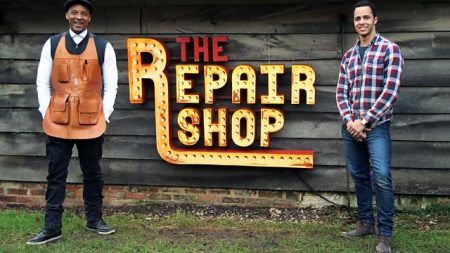The Covid-19 lockdown means that there’s a lot more TV viewing going on. Those TV scholars who are obsessed with Netflix and binge-watching will be missing the resurgence of broadcast TV. In Easter week, 6-12 April, “viewing to BARB measured TV grew by 23% in all time, 34% in daytime and 12% in 7pm-10.30pm peak, compared with the same, non-Easter week in 2019” according to Broadcast magazine. The really dramatic increase in daytime viewing shows two things: first that many more people are at home (obviously) but second that they are choosing to watch the most despised form of TV, everyday TV or ‘ordinary TV’ as Frances Bonner called it. It may also mean, though it is too early to tell, that older forms of TV watching are returning as well, particularly the shared and family viewing explored by Eva Novrup Redvall here last week.
Why is this happening? The factors include the creation of routines, the desire for consolatory entertainment and the need for connection. Broadcast ordinary TV fulfils all of these.
Lockdown advice frequently urges the establishment of routines to structure the day. The broadcast TV schedule provides a ready structure of routines with series offered the same time each week or, in the case of strip scheduling, each day. Strip scheduling is the mainstay of daytime, and ITV has just used strip scheduling to maximise the impact (and audience) for its 3 part Stephen Frears directed drama Quiz… itself celebrating that time just 20 years ago when Who Wants to be a Millionaire could attract an audience of 15 million or more. The routine element of ordinary TV has been explored in exemplary ways by scholars such as Helen Wheatley, Rachel Mosely and Helen Wood, and it remains an important feature of contemporary TV to many citizens, even before this crisis has brought it back to scholarly attention.
If aspects of routine TV seem a little domestic or female oriented, then it is worth reflecting on the insightful words of the Observer’s sports writer Jonathan Liew from that far-off time of 15 March when sports events began to close down. “For so many of us, sport isn’t simply a way of passing the time but a way of marking it. It offers a liturgy, a structure on which to measure the passing days and seasons… In frightening times, virus or no virus, these are the rituals that offer the veneer of normality, a background noise as reassuring and immutable as the ticking of a clock”. As with sport, so with ordinary TV.
Of course, sport and TV have an intimate relationship. Sport has been profoundly reorganised by TV schedules and finance, and the TV industry in turn driven by the business opportunities and technical challenges offered by sport. It is a relationship that, oddly, has not received much scholarly attention. Now that the ritual structures of television sport are suspended for the duration, where are the replacement ritualised broadcasts? Maybe we need to look no further than The Repair Shop on BBC1 on a Wednesday evening, with an audience of almost 6 million, 30% of those watching broadcast TV. This DIY show was, until recently, on daytime and it has already spawned a number of imitators.
Consolatory entertainment is the second reason for the return to broadcast TV. Consolatory entertainment does not challenge. It is comfortable and familiar; emotion rather than message. It is Mrs Brown’s Boys rather than Catastrophe; Sunday Night at the London Palladium (currently playing on Talking Pictures TV of a Sunday night incidentally) rather than The Tube; Antiques Roadshow (at 6 million viewers on BBC1, in the top 10 of shows) rather than Black Mirror. The cross media phenomenon of One World: Together at Home, is an exemplary form of consolatory entertainment. This 18 April concert, brought together by Lady Gaga, was streamed to an unknown number of people (streamers don’t publish their figures) and was repackaged by BBC1 and other broadcasters. The broadcast package version was watched by 21 million in the US according to Hollywood Reporter and an average of 5.4 million on BBC1. The UK version was interspersed by tributes to frontline medical and social support workers, a highly effective form of consolatory entertainment where emotion and empathy easily bring tears (“it’s hay fever season” as a clearly moved presenter Dermot O’Leary remarked ironically at one point). Light relief was provided by Charlie Watt’s air drumming in a broadcast that was a telethon fundraiser in the US, but devoid of fundraising in the UK (Britain leaves that role to 99 year old veterans walking round their gardens… much more effective).

Fig. 2: The Rolling Stones’ Mick Jagger, Keith Richards, Ronnie Wood and Charlie Watts perform during “One World: Together At Home” presented by Global Citizen on April, 18, 2020. Source: Forbes
This concert, and the role of its presenters like O’Leary, demonstrates the third reason for the resurgence of ordinary broadcast TV: the need for connection. Ordinary TV is peopled by on-screen presenters whose USP often lies in their very ordinariness. It’s difficult to remember who presents a genial magazine show like BBC1’s The One Show unless they are as awkward and wooden as Amol Rajan. The role of a presenter is to be as comfortable and relaxed as possible. They connect with viewers and bring people together as individual viewers. They use all the techniques of direct address, casual asides, harmless banter, topical references and occasional fluffs to achieve this. It’s something that grew very quickly in TV, but needed to be learned and perfected. Paddy Scannell summed up the way in which this form of address works in the idea of “the for anyone as someone structure”. The address is personal, but it can include almost any viewer who shares the language and at least some of the references. The ‘for anyone as someone’ structure is very different from the address of much social media, especially Facebook, which can be summarised as a ‘for no one in particular’. There is little sense of connection in Facebook, with its limited range of emoticon responses (still less with Twitter which prompts us to ‘love’ tweets about loved ones carried off by the virus). Facebook posts often excite dangerous emotions like jealousy and inadequacy which are problems for some users in ordinary times. These extraordinary times, with their very real practices of isolation, intensify the propensity of social media platforms to provoke troubling reactions. Reassurance is hard to find in social media, but it has long been an operating practice in ordinary broadcast TV. Graham Norton has perfected the ‘for anyone as someone’ mediation of major celebrities, providing the reassurance that they, like us, have mundane concerns and unexpected weaknesses, and he manages to wrap it all up in a comforting aura of fun that makes potentially painful confessions into a share moment of intimacy. For no one in particular forms of address just cannot replicate this.
Connection and reassurance, long the business of ordinary TV, have found their cultural role in this time of crisis. There is a new reality that we all share… and it has newly commonplace problems, one of which was dramatically demonstrated by Claudia Winkelman’s epic video connection failure on The One Show on 14 April, when presenter Alex Jones had to cut her off. An experience that has become an everyday one for us all.
John Ellis is Professor of Media Arts at Royal Holloway University of London. He leads the ADAPT project on the history of technologies in TV, funded by a €1.6 million grant from the European Research Council. He is the author of Documentary: Witness and Self-revelation (Routledge 2011), TV FAQ (IB Tauris 2007), Seeing Things (IB Tauris 2000) and Visible Fictions (1984). Between 1982 and 1999 he was an independent producer of TV documentaries through Large Door Productions, working for Channel 4 and BBC. He is chair of Learning on Screen and also oversees the Royal Holloway team working on EUscreen. His publications can be found HERE.







These points all well made, but there seem to me to be at least two other reasons for PSB’s resurgence. One is the Britishness of its programming as we are locked down in a specific national way, highlighting the differences betweeen us and, primarily, America. The other is news, which streamers significantly lack, whether this means 6.00 News, News at Ten,, BBC News or C4 News or indeed Sky, but equally impirtant are those quickly made programes onall channels which reflect back our locked-in situation to us – which previously produced American and international programming on the streamers conspicupusly lack.,